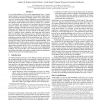Free Online Productivity Tools
i2Speak
i2Symbol
i2OCR
iTex2Img
iWeb2Print
iWeb2Shot
i2Type
iPdf2Split
iPdf2Merge
i2Bopomofo
i2Arabic
i2Style
i2Image
i2PDF
iLatex2Rtf
Sci2ools
ISPD
1998
ACM
1998
ACM
Filling and slotting: analysis and algorithms
In very deep-submicron VLSI, certain manufacturing steps – notably optical exposure, resist development and etch, chemical vapor deposition and chemical-mechanical polishing (CMP)– have varying effects on device and interconnect features depending on local characteristics of the layout. To make these effects uniform and predictable, the layout itself must be made uniform with respect to certain density parameters. Traditionally, only foundries have performed the post-processing needed to achieve this uniformity, via insertion (“filling”) or partial deletion (“slotting”) of features in the layout. Today, however, physical design and verification tools cannot remain oblivious to such foundry post-processing. Without an accurate estimate of the filling and slotting, RC extraction, delay calculation, and timing and noise analysis flows will all suffer from wild inaccuracies. Therefore, future placeand-route tools must efficiently perform filling and slotting prior to per...
Certain Density Parameters | Hardware | ISPD 1998 | Layout Optimization | Layout Optimization Loop |
| Added | 05 Aug 2010 |
| Updated | 05 Aug 2010 |
| Type | Conference |
| Year | 1998 |
| Where | ISPD |
| Authors | Andrew B. Kahng, Gabriel Robins, Anish Singh, Huijuan Wang, Alexander Zelikovsky |
Comments (0)

